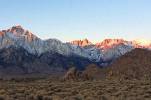Check with taxidermist on protecting prized mount
Like many of yours, my 2015 big-game hunt ended with a stop by the taxidermist's shop, where we left them in charge of creating a piece of artwork that will serve as a memoir of a hunting experience we look forward to reliving the rest of our lives.
Perhaps the experience you wish to remember is a wilderness elk hunt in Nevada's lonely backcountry, or the lengthy stalk of an antelope completed on hands and knees over rocky terrain, or maybe the long-awaited pursuit of a desert bighorn sheep. In my case, it is the fortuitous circumstances and generous friends that provided me the chance to harvest a beautiful mule deer buck just as it began to seem like the deck was being stacked against me at every turn.
Now that the months have gone by, if your taxidermist hasn't already done so, the time is fast approaching when he will call and invite you to come and inspect the final product.
Anyone who has had an animal mounted by a taxidermist knows that it is not an inexpensive proposition. When you include the hunt itself, all you went through to harvest your big-game animal in the first place and the cost of the taxidermy work, you will want to make sure your new mount is well taken care of so it will last through the years ahead.
One of the first steps to caring for your taxidermy art is selecting a good location to display it. Though it is tempting, avoid placing the mount in direct sunlight or directly opposite from a window that lets in bright sunlight. The intense lighting and even heat from the Nevada sun can dry out and otherwise damage the hide on your mount.
Something else to consider is whether you smoke in your home and where. Cigarette smoke, or even smoke from a fireplace, can cause the hair on your mount to yellow or otherwise discolor. If you smoke in your favorite chair, put your mount elsewhere.
Access to children and curious adults is another consideration when selecting a location. Kids are naturally curious and like to touch things, including an animal that has been mounted. They want to know what the hair feels like. While this may seem harmless enough, doing so can actually damage the hide. Antelope hair, for example, is brittle, and it doesn't take much touching to leave behind a mess.
Dust is another culprit that can damage your taxidermy art. In Southern Nevada, dust is just part of living in the desert, even if you live well inside the city. Dust can build up quickly on the hide or fur of your taxidermy work and can eventually attract dust mites and other insects that can damage a mount. Be sure to check with your taxidermist for suggestions before you start dusting.
Depending on the amount of dust in your area, you may get by with simply wiping the mount down with a feather duster or damp cloth. Over the years, I have had good luck using an upholstery attachment on the business end of a small, hand-held vacuum cleaner. Taking care to follow the grain of the hair, this approach not only removes dust but also grooms the hair. If needed, you can follow up the vacuum with a damp cloth or fine-bristled pet brush. And I can't overstate the importance of following the grain of the hair.
To restore luster to the hair on an animal mount, some taxidermists recommend gently wiping it down with Show Sheen. This is a product used for showing livestock, but there seems to be some disagreement between taxidermists as to whether this is a good idea. So this is where I remind you to check with your taxidermist for his recommendation.
For cleaning around the eyes, you can use a damp cotton swab to gently remove dust.
When it comes to horns and antlers, they can begin to show the passage of time and lose their natural coloring and luster. Vicky Werner, of Werner Family Taxidermy, recommends periodically treating antlers and horns by rubbing in a light coat of paste wax.
"It brings out their luster and the colors back, and it protects them from drying out," Werner said. "If you use a paste wax, I usually suggest every other year."
The bottom line is a little attention to your new mount will help it go a long way.
Freelance writer Doug Nielsen is a conservation educator for the Nevada Department of Wildlife. His "In the Outdoors" column, published Thursday in the Las Vegas Review-Journal, is not affiliated with or endorsed by the NDOW. Any opinions he states in his column are his own. He can be reached at intheoutdoorslv@gmail.com.























